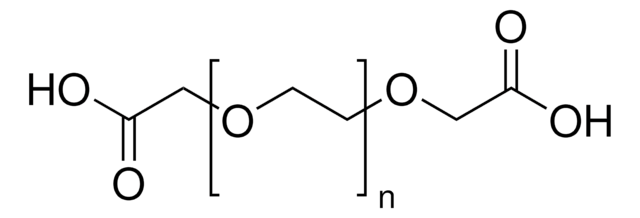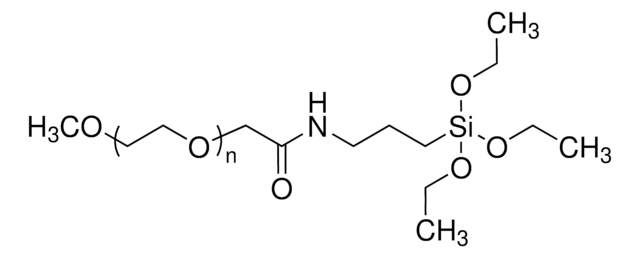450596
Poly(ethylene glycol) bis(2-ethylhexanoate)
average Mn ~650
Sinonimo/i:
PEG bis(2-ethylhexanoate)
Autenticatiper visualizzare i prezzi riservati alla tua organizzazione & contrattuali
About This Item
Formula condensata:
CH3(CH2)3CH(C2H5)CO(OCH2CH2)nO2CCH(C2H5)(CH2)3CH3
Numero CAS:
Numero MDL:
Codice UNSPSC:
12162002
ID PubChem:
NACRES:
NA.23
Prodotti consigliati
PM
average Mn ~650
Indice di rifrazione
n20/D 1.453 (lit.)
Viscosità
50 cP(25 °C)(lit.)
Punto di fusione
−48 °C (lit.)
Solubilità
H2O: insoluble
hexane, toluene, ethanol, and acetone: soluble
Densità
1.02 g/mL at 25 °C (lit.)
Stringa SMILE
OCCO.CCCCC(CC)C(O)=O
InChI
1S/C18H34O4/c1-5-9-11-15(7-3)17(19)21-13-14-22-18(20)16(8-4)12-10-6-2/h15-16H,5-14H2,1-4H3
XCQFTFZCTGZCNP-UHFFFAOYSA-N
Descrizione generale
Poly(ethylene glycol) bis(2-ethylhexanoate) (PEG-EH) is an ethylene acrylic elastomer that can be used as a low volatile plasticizer.
Applicazioni
PEG-EH can form a blend with polyvinylidene fluoride (PVDF) which can be used in the preparation of electrolytes for lithium batteries. It is also used as an additive for the development of ionization methods for mass spectroscopy.
Caratteristiche e vantaggi
Low volatility and good heat resistance. Compatible with a variety of polymers including polyesters and polyamides.
Codice della classe di stoccaggio
10 - Combustible liquids
Classe di pericolosità dell'acqua (WGK)
WGK 3
Punto d’infiammabilità (°F)
Not applicable
Punto d’infiammabilità (°C)
Not applicable
Dispositivi di protezione individuale
Eyeshields, Gloves
Scegli una delle versioni più recenti:
Possiedi già questo prodotto?
I documenti relativi ai prodotti acquistati recentemente sono disponibili nell’Archivio dei documenti.
I clienti hanno visto anche
Novel microporous poly (vinylidene fluoride) blend electrolytes for lithium-ion batteries
Wang H, et al.
Journal of the Electrochemical Society, 147(8), 2853-2861 (2000)
Jonathan P Williams et al.
Rapid communications in mass spectrometry : RCM, 21(11), 1693-1704 (2007-05-03)
A rapid method for the characterisation of polyglycol esters and ethers is described which uses accurate mass desorption electrospray ionisation (DESI) quadrupole time-of-flight mass spectrometry (Q-ToFMS). The results are combined with newly developed software which aids the interpretation of product
Klaus E Andersen et al.
Contact dermatitis, 70(2), 112-116 (2013-10-25)
Allergic reactions to spectacle frames are not unusual. A patient had a reproducible strong allergic patch test reaction to scrapings from the plastic material, and negative patch test results with available spectacle frame chemicals. To identify the culprit allergen in
A novel all-solid electrolyte based on a co-polymer of poly-(methoxy/hexadecal-poly (ethylene glycol) methacrylate) for lithium-ion cell
Zuo X, et al.
Journal of Materials Chemistry, 22(41), 22265-22271 (2012)
Research and development topics in Analytical Chemistry. Investigation of a cation exchange separation method for the determination of transition metal ions in anaerobic sealants
O'Dea P, et al.
Anal. Proc., 28(3), 82-84 (1991)
Il team dei nostri ricercatori vanta grande esperienza in tutte le aree della ricerca quali Life Science, scienza dei materiali, sintesi chimica, cromatografia, discipline analitiche, ecc..
Contatta l'Assistenza Tecnica.







